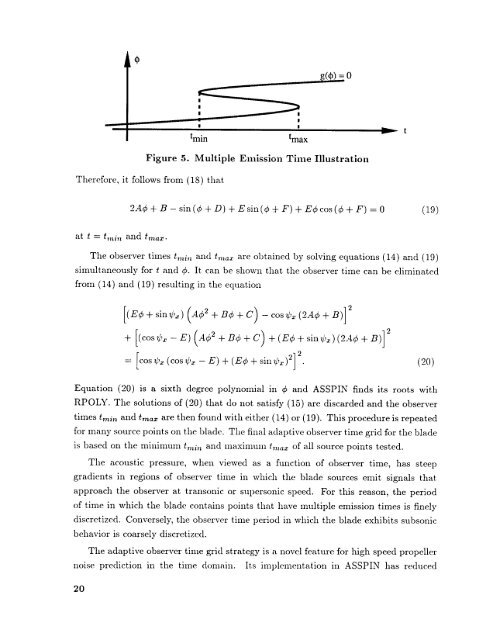Create successful ePaper yourself
Turn your PDF publications into a flip-book with our unique Google optimized e-Paper software.
|gtminBtmaxm..----Figure 5. Multiple Emission Time IllustrationTherefore, it follows from (18) that2A_b + B - sin (q5 + D) + E sin (_b + F) + EO cos (5 + F) = 0 (19)at t = train and tmax.The observer times train and t,,ax are obtained by solving equations (14) and (19)simultaneously for t and ¢_. It can be shown that the observer time can be eliminatedfrom (14) and (19) resulting in the equation[(E¢+sing'x)(Ag)2+Bc_+C)-cos_px(2A¢+ B)] 2+ [(cos g,x- E)(Aft 2 + B_ + C) + (E(p + sinOx) (2A(p + B)] 2--[cosg, x (cosg, x - E) + (E¢+ sin_px)2] 2 (20)Equation (20) is a sixth degree polynomial in ¢ and <strong>ASSPIN</strong> finds its roots withRPOLY. The solutions of (20) that do not satisfy (15) are discarded and the observertimes train and tma, are then found with either (14) or (19). This procedure is repeatedfor many source points on the blade. The final adaptive observer time grid for the bladeis based on the minimum train and maximum tmax of all source points tested.The acoustic pressure, when viewed as a function of observer time, has steepgradients in regions of observer time in which the blade sources emit signals thatapproach the observer at transonic or supersonic speed. For this reason, the periodof time in which the blade contains points that have multiple emission times is finelydiscretized. Conversely, the observer time period in which the blade exhibits subsonicbehavior is coarsely discretized.The adaptive observer time grid strategy is a novel feature for high speed propellernoise prediction in the time domain. Its implementation in <strong>ASSPIN</strong> has reduced2O

















